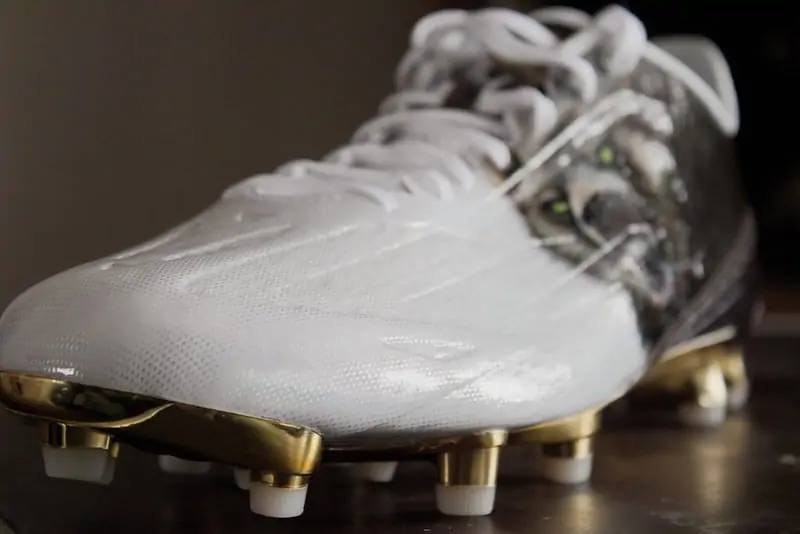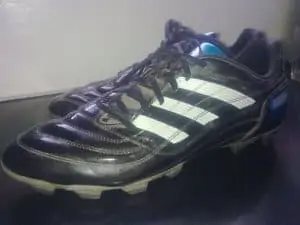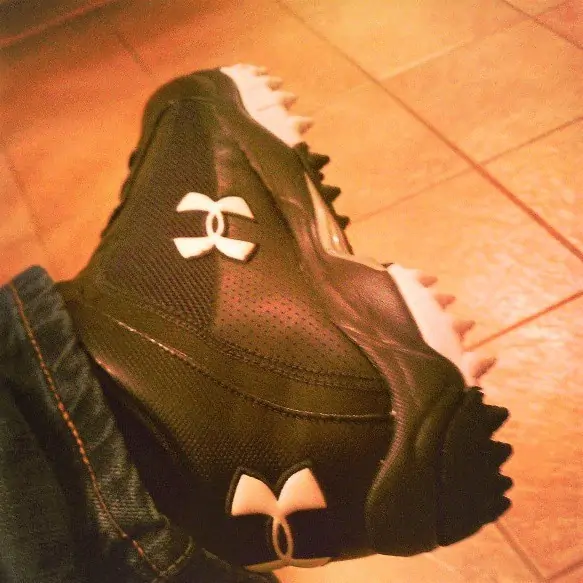Share the post "Soccer Cleats vs Football Cleats (Showdown!)"
With so many sports our children play, sometimes they can use the same apparel for different sports. So we’ll look at if soccer cleats are similar to other cleats.
Understandably, many parents (even those who know soccer) can get confused about soccer cleats vs football cleats. Especially if they already have football cleats, they may figure that the kid can also wear them for soccer.
Is there really a big difference between football and soccer cleats? We’ll outline the key information you need today including:
- Similarities and differences between the two cleats
- The purpose of cleats in soccer vs football
- If kids can and should wear football cleats to soccer
Read on to find out everything you need to know about soccer cleats vs football cleats!
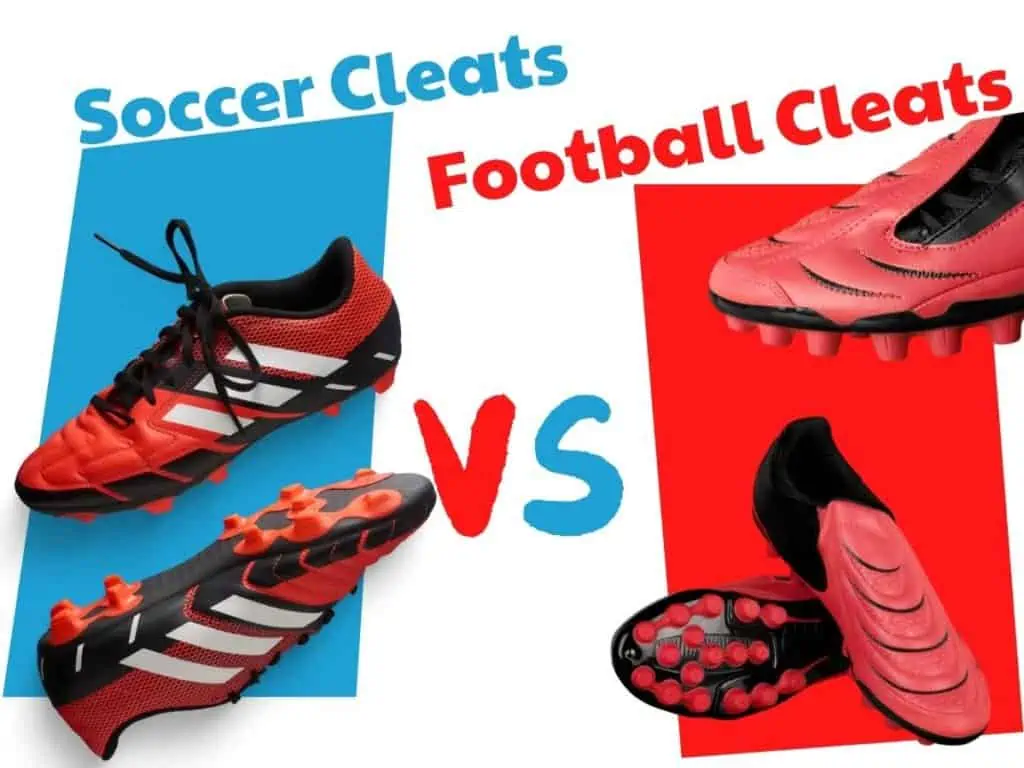
- Are Soccer Cleats The Same as Football Cleats?
- What Is The Difference Between Football and Soccer Cleats?
- What Do Soccer Cleats Look Like On The Bottom
- What're the Different Types of Soccer Cleats?
- Soccer Cleats vs American Football Cleats
- Can My Kid Wear Soccer Cleats for Football?
- Can You Use American Football Cleats for Soccer?
- Do Football Players Wear Soccer Cleats?
- Soccer Cleats vs Other Cleats
- Do You Need Cleats to Play Soccer?
Are Soccer Cleats The Same as Football Cleats?
Simply put, no soccer cleats are not the same as football cleats. If the cleats were the same, then there would not be two categories. Each type of cleat was specifically designed for the needs of the sport.
In soccer, you need cleats to provide traction on the surface, but also to allow optimal contact with a round ball. In football, most players only use the cleats for reactions.
kicker/punters do kick a ball, but it is a ball that’s shaped very differently from a soccer ball.
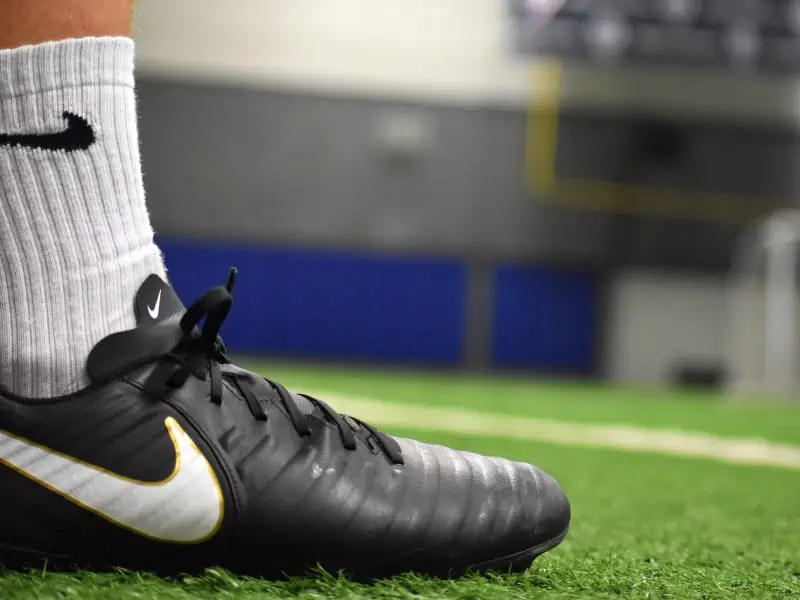
What Is The Difference Between Football and Soccer Cleats?
At first glance, soccer and football cleats seem pretty similar. However, when you take a moment to compare, you will see clear differences.
Here’s a helpful table to break down the differences between football cleats and soccer cleats:
| Category | Soccer Cleats | Football Cleats |
| Weight | Lighter weight for speed and touch | Heavier to protect |
| Material | Thinner, more flexible | Thicker, more protective |
| Studs | No toe spike | Extra toe spike and more studs |
| Rise | Low rise | Offers high-rise to protect the ankle |
| Shape | Narrow, tighter-fitting | Longer, wider, curved top |
What Do Soccer Cleats Look Like On The Bottom
The bottom of regular firm-ground soccer cleats (the ones you would wear on normal grass) contain the studs. Studs are what grips the grass and mud to provide traction.
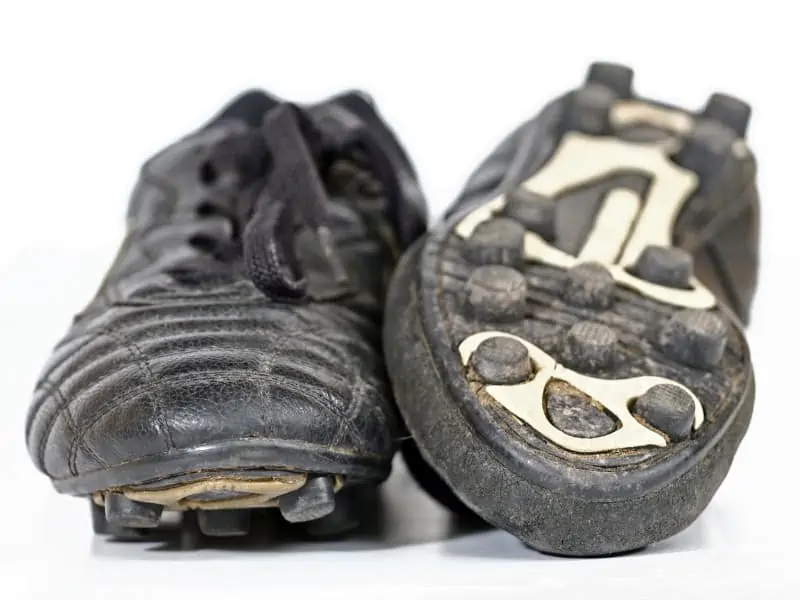
The exact shape and layout of studs can vary depending on the manufacturer and specific cleat style. In general, they tend to have foud studs near the heel in a sort of “square” shape. Then, around the toe box, the cleats often have 6 studs (3 along each side) with one in the middle.
You’ll notice that football cleats look a bit different. They have longer studs and more studs around the front of the cleat, including a toe stud.
This toe stud provides optimal traction for pushing against heavy opponents, but not for soccer-style play.
What’re the Different Types of Soccer Cleats?
- Long studded boots: recommended for very grassy or wet pitches. These screw-on studs are made from a combination of metal and plastic. They can be replaced or changed to studs made from different materials (usually plastic or rubber). Screw-in studs can have a maximum length of 21mm.
- Molded stud boots: These are for firm ground or artificial turf. There are usually a high number of rounded ‘mouldies’.
- Bladed boots: For firm and artificial ground. They can also come with metal tips, suited for damper surfaces.
- Astroturf boots: Designed for playing on astroturf, they have shorter studs to grip the turf.
- Indoor and futsal cleats: The surface of these fields is hard and required flat soles with no studs. Rubberized for high grip.
Soccer Cleats vs American Football Cleats
These are often similar in appearance to soccer cleats but are functionally and structurally quite different:
- The formation of the cleats on the outsole is different and they have a toe stud for extra traction. This can impede a soccer player.
- The weight of the outsole us generally heavier to support a larger athlete that is making heavier collisions.
- Many football players wear high-cut cleats for extra support.
- Some wear mid-cut cleats for mobility with ankle support.
- Low-cut cleats are worn by some players.
American football cleats originated similarly to soccer cleats but have changed a lot since:
- The formation of the cleats on the outsole is different and they have a toe stud for extra traction.
- They’re heavier.
- They’re usually mid or high-cut for extra ankle support.
Can My Kid Wear Soccer Cleats for Football?
So clearly, professional athletes tend to use specialized equipment for their sport. But not all of us get shoe deals and new cleats at the snap of a finger. Not to mention, kids’ feet are still growing.
To save time, money, and hassle, many parents want to know if their kids can wear soccer cleats for football and vice versa. The simple answer is this: probably, but it’s not ideal.
According to the rules of the game, soccer cleats are allowed in football, but they are not designed for football. Furthermore, football cleats are not usually allowed in soccer.
The official IFAB rules on player equipment do not specifically ban football cleats, but many referees view them as dangerous equipment. This is mostly because of the extra toe stud, which can do more harm than good for soccer players.
Do Kids Need Soccer Cleats?
Kids grow out of shoes and cleats quickly, which can make it hard to get all of the equipment they need for different sports. The truth is that a very young kid (3-5 years old) may not even need cleats to safely play soccer or football.
However, you may be tempted to use one pair of cleats for soccer, football, and other sports. This is not ideal and can impact your child’s performance and susceptibility to injury.
Still, if you can only choose one cleat, then soccer cleats are the most versatile option. Other sports, like football, permit soccer cleats.
Overall, it’s best to look for hand-me-downs, used cleats, and on-sale cleats to ensure your child has the ideal footwear for each sport.
Can You Use American Football Cleats for Soccer?
Certain positions in American football, such as linemen, involve using a lot of force and contact to block and tackle. Players may find themselves up against a 300+lbs man.
Therefore, the support and sturdiness of their cleats are of utmost importance. High-cut boots are popular in such positions.
Running backs get hit a lot, but they must also be quick and agile. A mid-height cut cleat is popular for this position as it gives a balance of support and mobility.
A few positions (such as receivers) wear low-cut, lightweight cleats (very similar to soccer cleats) for maximum mobility and speed.
Again, lacrosse and baseball have different requirements. Rapid direction changes and powerful explosive movements in lacrosse mean that a player should have higher ankle support.
In baseball, players need to be able to dig their cleats into the ground for a more solid base from which they can generate powerful throws and swings.
Do Football Players Wear Soccer Cleats?
While it’s rare, you may see a football wearing soccer cleats. Simply put, regular firm ground soccer cleats are permitted as American football cleats.
Let’s take a look at what the NFL says:
Article 3:Item 5. Improper Cleats. Shoe cleats made of aluminum or other material that may chip, fracture, or develop a cutting edge. Conical cleats with concave sides or points which measure less than ⅜-inch in diameter at the tips, or cleats with oblong ends which measure less than ¼ by ¾-inch at the end tips are also prohibited. Nylon cleats with flat steel tips are permitted.”
NFL Official Operations
Do Soccer Cleats Work for Football?
Both soccer cleats and football cleats have come a long way over the last 100 years. Now, each is specifically designed for the needs of their sport.
For most football players, soccer cleats don’t work well. They do not provide the same grip or support for pushing into others.
However, for players who run more (like wide receivers) or who kick the ball (kickers, punters, etc) soccer cleats may work well. Really, it depends on the player’s position and their personal preference.
Kickers or other players who’ve previously played soccer may find that soccer cleats work well for them in football.
Do NFL Kickers Wear Soccer Cleats?
If you visualize a football player wearing soccer cleats, chances are that you think of a kicker. After all, their job is sometimes more similar to a soccer player than a football player.
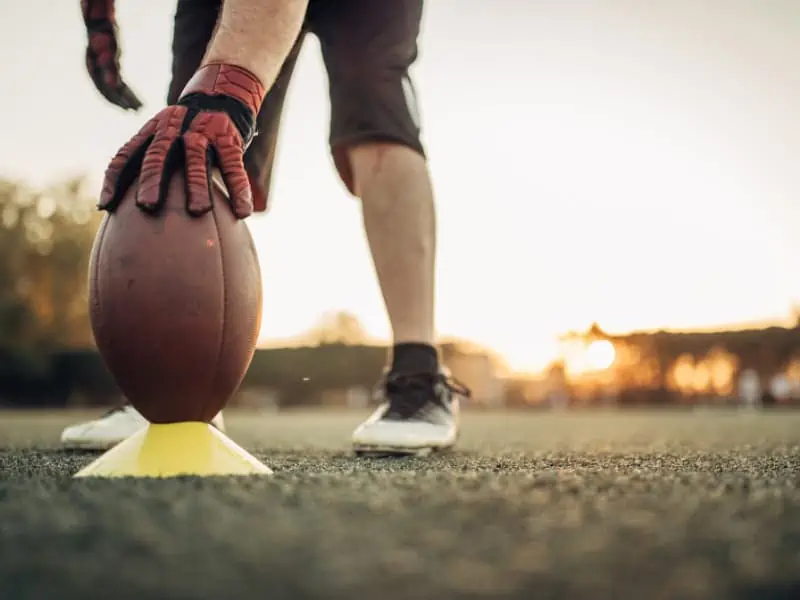
According to the Kicking Coach, “Most college and pro kickers wear a leather soccer cleat that is simple in design. Nike Tiempo cleats are the most popular kicking cleats at the moment.”
So yes, some NFL kickers have worn soccer cleats. One example is Matt Prater from the Denver Broncos. He wore customized CTR360 Trequartistas.
They must have worked pretty well, considering he broke Tom Dempsey’s 1970 record with a 64-yard field goal in Dec 2013.
What Cleats Does Justin Tucker Wear?
Justin Tucker wears Nike Mercurial Veloce III soccer cleats.
Remember Matt Prater’s record-breaking 64-yard field goal? Tucker beat that record in 2021 with a 66-yard field goal.
Interestingly enough, Tucker says he wears cleats for only two to three games before replacing them!
What Cleats Did Adam Vinatieri Wear?
Adam Vinatieri of the Indianapolis Colts also wore soccer cleats. He wears Under Armour Hydrastrike’s (on both feet).
He announced retirement in the spring of 2021.
Soccer Cleats vs Other Cleats
The main characteristics of a soccer cleat:
- Low cut.
- Lightweight.
- Made from materials suitable for striking a ball and constant movement.
Soccer players are of average height, have lean muscles, and weigh around 170lbs.
They run a whopping 7 miles in a 90-minute game. They’re constantly on the move, either jogging, sprinting, walking, or jumping.
For this reason, soccer cleats are designed to be lightweight, comfortable, and give freedom of movement, whilst offering support and protection.
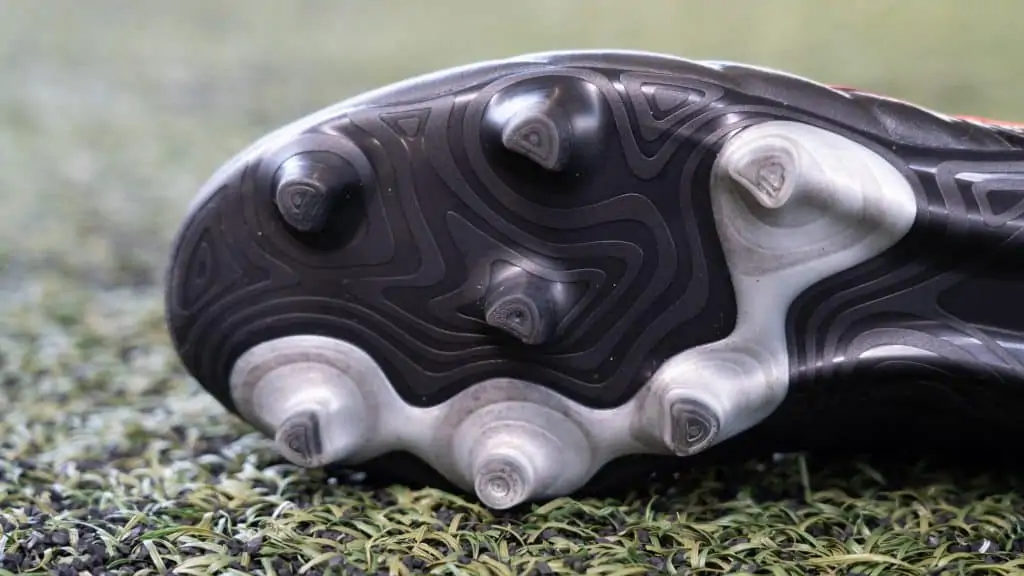
Soccer boots come in a few different forms. Some are based on different weather/pitch conditions:
- Long studded boots
- Molded stud boots
- Bladed boots
Another crucial element in the game of soccer is the act of striking a ball. The cleat must be made from suitable material for shooting and the position of the laces also plays a factor.
Up until recently, leather was the material of choice. There are now synthetic materials available to achieve the same effect.
Soccer Cleats vs Lacrosse Cleats
Lacrosse cleats are more uniform:
- They’re high-cut for stability and ankle support.
- They contain a toe cleat.
- The cleats are located on the edges of the sole.
Lacrosse cleats will cause problems when you’re trying to pass the ball on the turf.
With the position of their studs, when you swing underneath the ball, the studs will get caught in the turf, causing your pass or shot to go astray.
The short studs will also cause problems when the turf is long or wet, causing you to lose balance or slip.
Soccer Cleats vs Baseball & Softball Cleats
Baseball/Softball cleats are known as ‘spikes’ and are different from soccer cleats:
- The spikes are hard and thin, designed for digging into sand or grass to increase traction.
- They’re made from rubber, plastic or metal.
- They have a higher ankle cut than soccer cleats.
- Molded stud models are available for artificial turf.
Baseball and softball cleats are designed to be worn on bare soil without any turf. This is the reason for the number of short, pointy studs so that they can grip the dusty surface.
Some of the cleats have metal studs for extra grip which will be dangerous in soccer.
With the higher ankle cut, it will limit the movement of the ankle, restricting some passing and shooting moves.
Do You Need Cleats to Play Soccer?
Performance: Soccer cleats are made for the sport so that the player competes at the highest level. With many sports brands designing cleats in a billion-dollar industry, the standards are the highest.
The main reasons for the cleats being different are to do with the nature of the sports. Although there are some similarities between the sports mentioned above, they’re vastly different.
Once you have selected the correct soccer cleat for your field, the studs are designed for maximum grip.
Acceleration is vital in soccer and with the wrong grip, you will slip and lose possession.
Some cleats have extra long studs for grip and by wearing them, your feet will sink into the turf and feel heavy.
Striking the soccer ball is key. Some of the cleats mentioned above have a rim around the toe area and this will impede the strike.
What’re the Soccer Laws for Cleats?
Before the start of each soccer game, the officials check the cleats of the players. When a substitute is coming on the field, the official asks the player to show the bottom of the player’s cleats, to make sure that they are suited to the game.
It’s possible that you can wear some of the mentioned cleats playing soccer against friends, but it’s not advised because of performance and safety reasons.
Do Soccer Cleats Make a Difference?
You can easily cause yourself an injury by slipping on the turf. Plus, if you’re unable to control yourself when running at top speed, this can endanger an opponent.
Sometimes accidentally, studs will catch another player, when you’re kicking the ball or sliding. Some of the studs used in the other games are not designed with the possibility.
If you don’t have the correct cleats when playing, it’s like you will be asked to leave the field and change them. If that is not possible, then you will have to be substituted.
Do Soccer Cleats Make You Kick Better?
Wearing soccer cleats won’t magically make you a perfect kicker, but the shoes are designed for kicking function. One review paper sought to examine just how helpful soccer cleats are for kicking.
It was found that soccer shoe design can have a substantial influence on sprinting performance, improve kicking accuracy, and influences maximum kicking velocity.
The influence of soccer shoe design on playing performance: A Series of Biomechanical Studies
If you need some special cleats to play soccer, look at our great collection of soccer cleat articles here.
Share the post "Soccer Cleats vs Football Cleats (Showdown!)"
Joel is a seasoned soccer journalist and analyst with many years of experience in the field. Joel specializes in game analysis, player profiles, transfer news, and has a keen eye for the tactical nuances of the game. He played at various levels in the game and coached teams - he is happy to share his insight with you.

